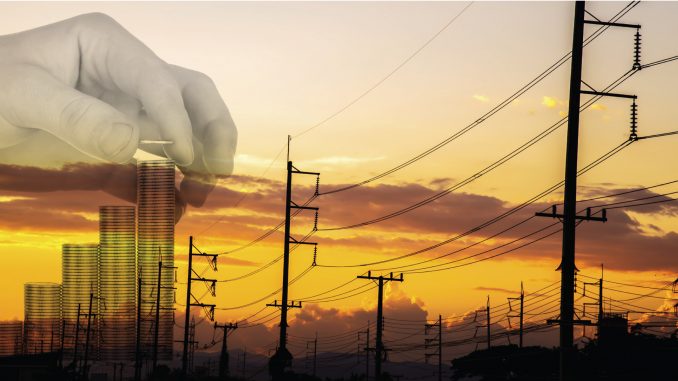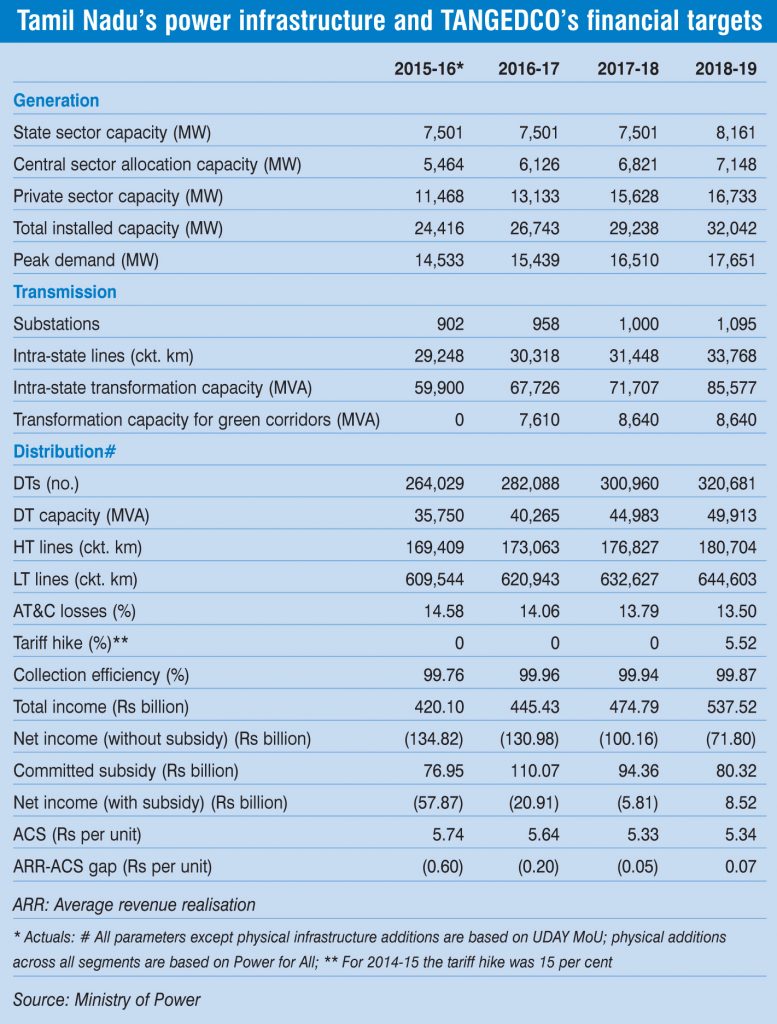
Tamil Nadu has joined hands with the Ministry of Power (MoP) to carry forward sector reforms. On January 9, 2017, a tripartite MoU was signed between the MoP, the state government and the Tamil Nadu Generation and Distribution Corporation (TANGEDCO) for implementing the Ujwal Discom Assurance Yojana (UDAY) in the state. The objective is to achieve a financial turnaround of TANGEDCO through operational and financial efficiencies. The state government also executed the Power for All document with the MoP on the same day.
Tamil Nadu is expected to benefit in multiple ways from UDAY. These include financial benefits such as savings in interest costs, reduction in aggregate technical and commercial (AT&C) losses, and central government assistance through various schemes. The state government is expected to save Rs 110 billion over the next three years, thereby having recurring annual savings of Rs 70 billion-Rs 80 billion thereafter.
In order to provide 24×7 Power for All, the state government is making efforts to improve electricity access and availability. Tamil Nadu has achieved 100 per cent village electrification and is working on household level access. Further, it is building new generation and transmission capacity apart from providing subsidy to supply free electricity of 100 units bimonthly to all domestic category consumers.
The following are the salient features of the MoU signed by Tamil Nadu to join the UDAY and power for all schemes:
UDAY
- Tamil Nadu became the 21st state to join UDAY, resulting in 92 per cent of the country’s discom debt being covered under the central government scheme since its launch in November 2015.
- TANGEDCO, which is an integrated utility involved in generation and distribution, had accumulated losses of Rs 558.21 billion as of March 31, 2016. Its revenue deficit for 2015-16 was Rs 57.87 billion while cost recovery was only 90 per cent of the average cost of supply (ACS). The discom’s outstanding debt stood at Rs 813.12 billion as of September 2015, including a state government loan of Rs 62.23 billion and Restructured Accelerated Power Development and Reforms Programme (R-APDRP) loans of Rs 11.5 billion.
- UDAY covers TANGEDCO’s debt of Rs 304.2 billion. Of this, the state government will take over 75 per cent or Rs 228.15 billion before March 2017. The scheme provides for the remaining 25 per cent debt to be repriced or issued as state-guaranteed discom bonds, at a coupon rate of not more than the bank base rate plus 0.1 per cent. As a result, the state will be able to save annual interest costs of about Rs 9.5 billion through debt reduction and lower interest rates.
- As per the MoU, after taking over 75 per cent of the discom debt, the state government will provide the amount as a grant to TANGEDCO in five equal instalments of Rs 45.63 billion each year starting from 2016-17 to 2020-21. In the first year, the balance amount of Rs 182.52 billion (after deducting the grant amount) will be transferred back to TANGEDCO as interest-free loan. This loan will keep declining each year corresponding to the grant amount to become zero by the end of the fifth year. The state government has agreed to pay all the outstanding dues to TANGEDCO for power supply by March 2017. Further, the government must issue non-statutory liquidity ratio bonds either in the market or directly to the discom lenders to raise funds for providing the grant and/or interest-free loan to TANGEDCO.
- In line with this provision, on February 20, 2017, the state government proposed to issue special securities worth Rs 140 billion under UDAY, according to a Reserve Bank of India notification. The interest on the securities will correspond to the yield on government securities at the close of February 17, 2017.
- On its part, TANGEDCO has committed to improving its operational efficiencies. It has agreed to the AT&C loss reduction trajectory of 13.5 per cent by 2018-19 as compared to 14.58 per cent as of March 2016. The state government has committed to reducing transmission losses from 4.11 per cent to 3.89 per cent by 2019-20. The reduction in AT&C and transmission losses is expected to bring additional revenues of around Rs 16 billion to the discom.
- TANGEDCO will have to take several measures in order to achieve loss reduction. These include compulsory feeder metering (by June 2017) and distribution transformer (DT) metering (by June 2018), energy audit of up to 11 kV in rural areas (by March 2019), physical feeder segregation (by December 2019), consumer indexing and geographic information system mapping of losses, upgrade/change transformers and meters, smart metering of high-end consumers (with consumption of 200 units and above by December 2019), implement enterprise resource management or enterprise resource planning for better inventory, personnel and accounts management (by March 2019). Further, AT&C loss reduction targets at the subdivision and circle levels have to be prepared and the responsibility to achieve these must be assigned to the concerned officers.
- TANGEDCO will also undertake demand-side management (DSM) interventions under UDAY to reduce peak load, flatten the load curve and reduce energy consumption in the state. The measures include promoting the use of energy efficient LED bulbs, agricultural pumps, fans and air conditioners, as well as efficient industrial equipment through the Perform, Achieve and Trade (PAT) scheme. The gains through this exercise are expected to be around Rs 23 billion. Meanwhile, the state government has agreed to replace street lights with LEDs in all municipal towns.
- Other measures that TANGEDCO needs to undertake include timely filing of tariff petitions before November each year, preparing annual accounts, improving customer services through timely complaint resolution, introducing more options for bill payment, and increasing employee engagement through capacity building and the incentive-penalty scheme based on key performance indicators. It must also identify the key personnel for implementing UDAY. TANGEDCO will continue to procure power through the transparent competitive bidding process.
- The central government will help the discom improve the state’s power infrastructure. If the discom meets the operational milestones outlined under UDAY, the centre will extend additional or priority funding through central programmes such as the Deendayal Upadhyaya Gram Jyoti Yojana (DDUGJY), Integrated Power Development Scheme (IPDS) and Power Sector Development Fund (PSDF). Further support will be available through additional coal at notified prices, permission for coal swapping, coal rationalisation, correction in coal grade slippage, and availability of 100 per cent washed coal (from October 2018). All these measures will help the state reduce power costs. The state is expected to gain Rs 43.2 billion on account of coal reforms.
- With the improvement of discom performance, TANGEDCO’s rating will also improve, thereby giving it better access to cheaper funds for its capex requirements.
Power for All
- Under the scheme, the state is required to undertake initiatives to expand its power infrastructure in line with the projected increase in power demand. The centre will facilitate these initiatives through support from schemes like the IPDS and the DDUGJY. The overall objective is to provide 24×7 reliable and quality power to consumers across all categories.
- According to the 2011 census, Tamil Nadu fared well in terms of household electrification at 93.4 per cent as compared to the national average of 67.2 per cent. As of March 2016, the state achieved close to 100 per cent village and household electrification except 5,787 remote households that are proposed to be electrified using off-grid solutions. With the growth in generation resources over the years, the peak deficit was brought down to zero in 2015-16, a trend that is continuing in 2016-17. Further, the state is maintaining almost 24 hours of power supply for all consumer categories.
- Power demand in the state is expected to grow at 7 per cent. TANGEDCO has predicted the peak demand to reach 17,651 MW by 2018-19. The state had an installed capacity of 24,433 MW as of March 2016, including a renewable capacity of over 9.6 GW. In order to meet future demand, capacity addition of 2,509 MW from thermal sources and 5,100 MW from renewable sources is expected by March 2017. The under-implementation projects are on track and bottlenecks with regard to fuel linkage are being addressed. For instance, TANGEDCO has MoUs with MMTC Limited for imported coal 17.93 million tonnes per annum for five of its upcoming coal projects. Of these, it has received allotment of the Chandrabila coal block for three plants and is awaiting allotment from indigenous sources for two projects – the NCTPP Stage III and the Uppur thermal plants, which are expected to be commissioned after 2018-19. The discom may get priority during future allotments given that it is now a signatory to UDAY.
- In terms of transmission infrastructure, the intra-state network, owned by the Tamil Nadu Transmission Corporation (TANTRANSCO), comprised 29,248 ckt. km of transmission lines and 902 substations with 59,900 MVA of capacity as of March 2016. This is expected to grow to 33,768 ckt. km and 94,217 MVA of capacity by 2018-19 including 8,640 MVA associated with the renewable corridor. TANTRANSCO has planned a capex of Rs 203.1 billion to meet the projected demand in the state and to provide connectivity to the upcoming renewable energy corridor projects.
- TANGEDCO is at advanced stages of completing works under the Rajiv Gandhi Grameen Vidyutikaran Yojana, and is currently implementing R-APDRP projects as well as Asian Development Bank-funded schemes. The discom plans to invest Rs 93.48 billion in distribution infrastructure including 35,059 km of low tension (LT) network and 56,652 DTs between 2016-17 and 2018-19. The LT network and number of DTs at the end of 2018-19 will reach 644,603 km and 320,681 respectively. The discom is conducting load surveys for identifying the energy saving potential in various sectors. Based on this, a DSM action plan will be formulated for maximising the use of energy efficient appliances.
- A tariff hike of 5.52 per cent is required for TANGEDCO to turn around operationally by 2018-19, provided the discom achieves its AT&C loss targets. The state government is providing financial assistance through subsidy (which increased to Rs 66.95 billion in 2015-16 from Rs 20.71 billion in 2011-12) and the financial restructuring plan (FRP), which was approved in 2012-13. Under the FRP, the government took over Rs 63.54 billion worth of discom loans and interest liability, and restructured the remaining Rs 59.51 billion of loans with banks for a 10-year tenor, including a three-year moratorium period.
UDAY aims to achieve a financial turnaround of the power distribution business and make it more sustainable. This, along with the Power for All programme, is expected to result in higher power demand, which will, in turn, lead to better utilisation of generation resources and lower electricity costs. Tamil Nadu is expected to benefit from both these central schemes provided the state utilities are able to deliver on their commitments in a timely manner.

